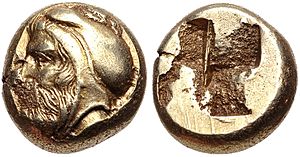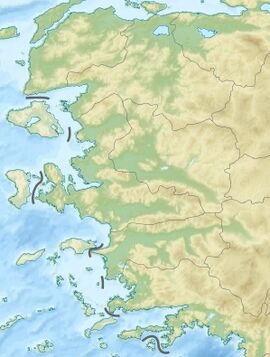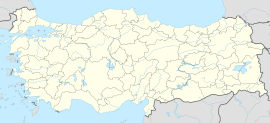Phocaea facts for kids
|
Φώκαια
Foça |
|

The theatre of Phocaea
|
|
| Alternative name | Phokaia |
|---|---|
| Location | Foça, Izmir Province, Turkey |
| Region | Ionia |
| Coordinates | 38°40′03″N 26°45′29″E / 38.66750°N 26.75806°E |
| Type | Settlement |
Phocaea (pronounced Foh-KAY-uh), also known as Phokaia, was an important ancient Greek city. It was located on the western coast of what is now Turkey. This area was once called Anatolia. Phocaea was part of a region known as Ionia.
People from Phocaea were great sailors. They founded several new cities, called colonies, far away. These included Massalia (today's Marseille, France) around 600 BC. They also founded Emporion (now Empúries, Spain) in 575 BC. Another colony was Elea (modern Velia, Italy) in 540 BC.
Contents
Discovering Phocaea's Location
Phocaea was the most northern city in the Ionian region. It was located near where the Gediz River (called Hermus in ancient times) meets the sea. The city was on a peninsula. This land was between two large gulfs: the Gulf of Cyme to the north and the Gulf of Smyrna (now İzmir) to the south.
Phocaea had two natural harbors close to the city. These harbors had many small islands. The excellent harbors helped Phocaea become a strong naval power. This means they had a powerful fleet of ships. Their sea power greatly shaped their culture and economy.
Archaeologists have found that Phocaea was a large city for its time. The ancient historian Herodotus wrote that Phocaea's city walls were very long. This shows how big and important the city was.
Ancient Persian Tomb Near Phocaea
About 7 kilometers east of Phocaea, there is an ancient Persian tomb. It is known as Tas Kule, or "rock tower." This tomb was carved directly into solid rock. It has a lower part that is 2.7 meters high and measures 9 by 6 meters. Above it is a second part, 1.9 meters high, measuring 3 by 3 meters.
Four steps connect the two levels of the tomb. This style shows a strong Persian influence. Most archaeologists believe this tomb was built for a Persian noble or a local leader who served the Persians. It looks similar to the tomb of Cyrus the Great.
Phocaea's Long History

The ancient Greek writer Pausanias tells us how Phocaea was founded. He says people from Phocis, led by Athens, started the city. They were given land by the Cymaeans, who were from the Aeolian region. Phocaea then joined the Ionian League, a group of Ionian cities.
Pottery found at the site shows that Aeolian people lived there until the 9th century BC. Ionian people arrived by the end of the 9th century BC. This helps us guess when Phocaea was first settled.
Phocaeans: Master Sailors
According to Herodotus, the Phocaeans were the first Greeks to travel very far by sea. They explored the coasts of the Adriatic Sea, Tyrrhenian Sea, and Spain. Herodotus says that Arganthonios, the king of Tartessus in Spain, was so impressed by them. He invited them to live in his land. When they said no, he gave them a lot of money to build strong walls around their city.
Their sea voyages were truly amazing. To the south, they likely traded with Naucratis in Egypt. This was a Greek colony founded by their fellow Ionian city, Miletus. To the north, they probably helped settle Amisos (modern Samsun) on the Black Sea. They also helped with Lampsacus at the northern end of the Dardanelles (ancient Hellespont). However, Phocaea's most important colonies were in the west. These included Alalia in Corsica, Emporiae and Rhoda in Spain, and especially Massalia (Marseille) in France.
Persian Rule and Resistance
Phocaea remained independent for a long time. But during the rule of the Lydian king Croesus (around 560–545 BC), it fell under Lydian control. Then, in 546 BC, Cyrus the Great of Persia conquered Lydia and Ionia. This was one of the first battles of the great Greco-Persian Wars.
Instead of giving in to Persian rule, many Phocaeans left their city. Some may have gone to Chios, an island nearby. Others went to their colonies in Corsica and other parts of the Mediterranean Sea. Some eventually returned to Phocaea. Many, however, became the founders of Elea in Italy, around 540 BC.
In 500 BC, Phocaea joined the Ionian Revolt against Persia. This revolt was a fight for freedom. A Phocaean named Dionysius was chosen to lead the Ionian fleet. This was at the important Battle of Lade in 494 BC. However, Phocaea could only send three ships to the battle. This showed that their power was declining. The Ionian fleet was defeated, and the revolt ended soon after.

After the Greeks defeated Xerxes I in 480 BC, Athens became very powerful. Phocaea then joined the Delian League, a group of Greek city-states led by Athens. Phocaea had to pay money, called tribute, to Athens.
In 412 BC, during the Peloponnesian War, Phocaea rebelled against Athens. They did this with help from Sparta. Later, the Peace of Antalcidas treaty in 387 BC gave Persia control over Ionia again.
In 343 BC, the Phocaeans tried to attack Kydonia on the island of Crete. But they were not successful.
Later History and Decline
During the Hellenistic period, Phocaea was ruled by the Seleucid Empire. Then it came under the Attalid dynasty. In the Roman period, the town was known for making ceramic pots. One famous type was called Phocaean red slip.
Later, a Genoese ambassador named Benedetto Zaccaria gained control of Phocaea. He received it as a hereditary lordship. Zaccaria and his family made a lot of money from their properties there. They especially benefited from the rich alum mines. Phocaea remained a Genoese colony until the Turks took it in 1455. Today, it is a titular see of the Roman Catholic Church, which means it's a historical bishopric.
In 1914, Phocaea experienced a difficult time. There was a massacre against Greek civilians by Turkish groups.
Phocaea's Ancient Coins
The Phocaeans were among the first people in the world to make and use coins as money. They probably learned this from the Lydians. Their earliest coins were made of electrum. This is a natural mix of silver and gold. The British Museum has a Phocaean coin from 600 to 550 BC. It shows the image of a seal, which was a symbol of the city.
See also
- Cyme (Aeolis)
- 25 Phocaea, an asteroid named after the city
- List of ancient Greek cities




